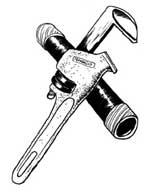|
Ceiling Repair - Done Properly the First Time
A ceiling repair job is no different than any repair job in that there is a source for which the damage has been done. The source of the ceiling damage will need to be determined and fixed before the ceiling repair can be completed. The source could be a number of different things from a roof leak to shifting of the house due to frost heaves to a lack of proper insulation. The damage will usually tell you what the problem is if it is left long enough. If the source of the damage is not fixed first, then your ceiling repair job may need to be done more than once over a period of a few years. So, once you have determined the source of the damage and repaired that problem you are ready to finish the ceiling repair job inside. First start by determining if the drywall needs to be removed or whether it can stay and be patched. For larger jobs you will need to remove the drywall. Usually you would cut extra of the old drywall back to the studs. The insulation above the drywall may also need to be removed and replaced if it is wet or moldy. Be sure to remove ALL the damaged materials to remedy the entire problem! If needed, take a larger piece of the drywall to make sure you get the entire damaged problem. If the area you are repairing is damp, be sure to let it dry out completely before you start to apply the new drywall. An industrial fan can be used to speed up the drying time. When removing the drywall be sure to remove it so that you have studs to screw the new piece of drywall to. If not, you may need to attach a wood strip to the existing studs in order to secure the new piece of drywall. Cut out a piece of drywall to fit the hole for your ceiling repair exactly. Use drywall screws to secure the drywall to the joist. Once the new piece of drywall is secured in place it is time to tape it and put a coat of drywall putty on it. For a textured ceiling repair you will need to buy a spray texture-repair kit in order to get the same texture to match it up. Stucco can also be applied with a sponge. Apply a thin coat of compound over the bare joints and screws and cut a piece of drywall tape to place on the wet compound over the joint. Apply another coat of drywall compound directly over the tape an squeegee out the excess drywall compound. After it has dried apply another coat of drywall compound and allow to dry again. Sand off smooth with a fine grit sand paper. Apply as many coats as necessary to smooth it out. Whether you are moving a light fixture or repairing damage from a roof leak the process is the same once you have replaced the piece of drywall affected. For cracks in drywall, once the source of the problem has been eliminated, apply a thin coat of compound down the crack followed by a strip of drywall tape and another coat of drywall compound and squeegee to a smooth surface. Repeat as necessary. For exposed nails the method is similar. In my case I decided to pull out every nail and replace with drywall screws. It is the only sure method to eliminate the problem of the nails moving down through the ceiling again. I did not put as many screws back into the piece of drywall as nails I took out but I still had to repair every nail hole in the drywall. In some cases it may be easier to replace the entire piece of drywall rather than repair the existing one. Spots of mildew, water stain and moisture on a ceiling may indicate a lack of insulation in the attic above. We had this problem and it was a simple fix. I went into the attic and added some more insulation and made sure that the insulation was fitting snug between the joists. The ceiling can be repainted once the problem is eliminated. Most ceiling repair jobs are not this easy; we were lucky this time.
Return to Family Handyman Questions Home Pagr From Ceiling Repair
|
Family Handyman Quick Links
Looking for a Toronto plumber? Hiring a plumber can effectively fix your plumbing!
Download free Handyman clipart
Download free Handyman Business forms


